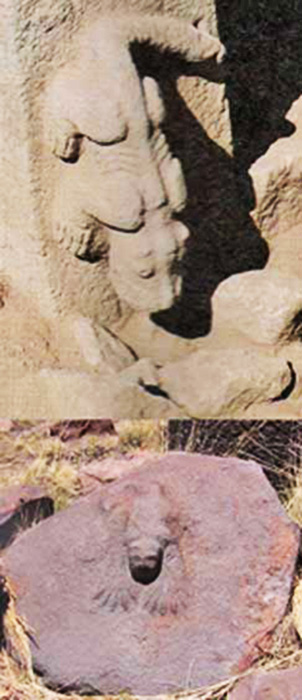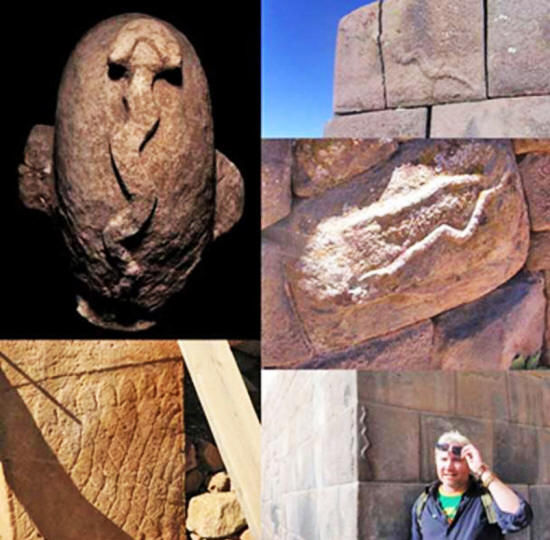|
31 March, 2021 from Ancient-Origins Website
Top left: Cuzco, Peru. Top right: Western Italy. Bottom left: Alaca Hoyuk, Turkey. Bottom right: Casing stones on pyramid on Giza plateau. (Author provided)
Göbekli Tepe was flourishing an astonishing 12,000 to 14,000 years ago. Today the preserved remains still exhibit high degrees of sophistication and megalithic engineering skill.
Back in the 1990's when Robert Schoch exclaimed that the Sphinx could be many thousands of years older than previously thought, he was ridiculed.
Graham Hancock's popular theories of a 12,000-year-old Ice Age civilization were slammed.
With Göbekli Tepe we now have a unique and remarkably ancient complex that has been carbon-dated by German archaeologists to the end of the last ice-age that is shaking the foundations of science and history and awakening an interest in our human origins.
I joined forces with authors Andrew Collins and Graham Hancock on a Megalithomania expedition around Turkey to investigate this enigmatic discovery. Graham was as astonished as I was.
For such an old
structure, the quality of stonework and abstract artistic skill just
seems too advanced for its era. T-shaped pillars and a fox relief at Göbekli Tepe. (Author provided)
He also discovered some broken fragments of beautifully crafted T-shaped blocks with relief carvings. However, due to the superior quality of the stonework, they were classified as Byzantium artifacts.
Interestingly this stone, now on display in Urfa Museum, looks conspicuously like one I had previously seen at Sillustani in Peru.
In 1994, a German archaeologist named Klaus Schmidt recognized Göbekli Tepe as part of the "pre-pottery Neolithic" culture because this style of carving was similar to a site he had worked at earlier:
What strikes people when they visit this site is the intricacy of the stonework, the size of the megalithic pillars, and the sheer magnitude of the man-made hill it was carefully covered with.
The original construction
was built on solid bedrock, then mounds were constructed on top of
these, and further structures built on top over a period of around
two thousand years, with the final enclosures containing smaller
stones and less sophistication than the earlier levels.
Some pillars seem to represent strange, abstract statues of humans, wearing space-age belts, with long, bent arms and 'H' type letters (on every pillar in enclosure D).
Most impressive is a strange creature in three dimensional high-relief showing beautiful craftsmanship and originality (for that period).
There are several types
of relief carvings at Göbekli Tepe. The 3D high-relief, the shallow
reliefs of animals, 'H's, and the humanoid arms and belts, plus a
rougher style that occurs on the later levels, although incredibly,
this still dates to around 8,000 years old.
Why choose such a specific design...?
It is an abstract
construction that sits gently on the bedrock, in very shallow pits.
Some of the pillars are 18 ft high (5.48 meters), with the top part
of the "T" carved to look like it is a separate block to the main
pillar, although it is actually one piece.
Another interesting
aspect of the site are the unusual cup-marks that are found, mainly
on the bedrock, but also on top of some of the oldest pillars, that
may at some point shed some light on the cup-mark phenomenon in
Britain, many thousands of years later.
Cup-marks and a pillar base at Göbekli Tepe. (Author provided)
Its earliest inhabitants were the Hattians, who were earth-based goddess worshipers, with roots in the Stone Age, who flourished from around 2350 BC to 1700 BC.
Although much younger
than Göbekli Tepe, the megalithic walls are indistinguishable from
polygonal walls found all over Peru.
During my travels, I have seen them all along,
Although separated by
many millennia and vast distances, this style is possibly the most
difficult style to accomplish, as each block needs to be carved with
extreme accuracy so that they fit together and stay together over
the years, even through earthquakes. However, at Alaca Höyük and nearby Hattusu, they are not flat-faced walls.
They look 'puffy', basically protruding from the joins, which some researchers say look like pillows. It does not seem to follow any particular plan, but it was a popular technique favored by the ancient megalith builders.
This begs the question,
On witnessing so many
similarities to sites in Peru and Bolivia, there was only one thing
to do.
Top left: Sillustani, Peru. Top middle: Cutimbo, Peru. Bottom left: Sillustani. Top right: Pillar at Gobekli Tepe. Bottom right: The first artifact found at Gobekli Tepe, originally thought to be Byzantium. (Author provided)
We headed to Cuzco, known as "The Navel of the World."
Interestingly, Göbekli
Tepe's name has a similar meaning ("Hill of the Navel") and is one
of many "world navels" or "sacred centers." Cuzco is a megalithic
city. Its foundations are made up of polygonal and precision carved
stone, which is quite a sight when you first visit there.
On high bluffs, always with a steep climb up to them, these towers are a mystery, made with startling engineering precision, obviously meant to last for several generations.
The most famous example
is
Sillustani, a site I have visited
many times.
The mystery here is that it is an almost perfect match of one of the platforms on Easter Island, some 2,600 miles (4184.29 km) away across the Pacific Ocean.
Sillustani has several relief carvings that closely resemble those at Göbekli Tepe, including serpents, lizards, foxes, pumas, and other unusual creatures.
One tower that is partly
intact shows a beautiful, but very weathered lizard that can only be
seen at certain times of day when the sun reaches round to its
location on the tower. Perhaps as the sun revolved around the circular towers, the reliefs got exposed only at certain times of day.
I wonder if Göbekli Tepe
was used in a similar way, as whoever repaired the site and covered
it with thousands of tons of dirt, may have wanted to keep the
pillars, and therefore the reliefs, in their correct position,
suggesting they may hold astronomical secrets that have yet to be
deciphered.
The stonework here reaches another level of complexity, with the beautiful "puffy" polygonal stonework, along with some exquisite reliefs, including serpents, pumas, and even faces of creatures emerging from the rock.
As you can see from the
images, the similarities to Göbekli Tepe are there. The faces that
emerge from the rock look like the stone 'totem' statue found at
Göbekli Tepe, now in Urfa Museum. Near the entrance to Cutimbo amongst piles of broken stone, a unique relief of a cheeky critter sits upon a lump of rock that was once part of one of the towers.
It looks like some kind of feline, but its’ unusual elongated fingers are an anomaly.
This one closely
resembles the vertical creature on the solitary high-relief at
Göbekli Tepe.
Right: Totem statue from Gobekli Tepe. Bottom: Chulpa tower at Cutimbo, Peru. (Author provided)
It has been labeled "The Rosetta Stone of South America."
Not only does it suggest Sumerian visitors once arrived on the shores of Lake Titicaca, it has now been translated and the use of this type of script has been dated to 3,500 BC.
What does this mean?
It certainly looks like
there was an ancient visit
by Sumerians around 5,500 years ago, and
when we look at the location of where this language was being used,
suddenly we see a direct connection between Tiwanaku and the
builders of Göbekli Tepe and surrounding sites.
Top: Gobekli Tepe relief. Bottom: Relief at Cutimbo, Peru. (Author provided)
However, since his initial deductions, this date has been revised several times, with the Fuenta Magna bowl possibly nailing down one date at least.
When you visit Tiwanaku and Puma Punku, they look like a cataclysm has given its best shot to destroy them a very long time ago, and with the evidence of,
...we must reconsider the idea that
perhaps the Fuenta Magna bowl is in fact just part of a long
cross-cultural bond that had existed for thousands of years.
Top right: Gobekli Tepe "H" motifs. Bottom right: "H" blocks from Puma Punku, Bolivia. (Author provided)
Carving high-reliefs, constructing polygonal walls, quarrying and transporting super-sized megaliths, are not things that that can be put away as simple "coincidences" that any culture would just come up with, as they are all particularly difficult to achieve.
Since the discovery of Göbekli Tepe, the re-dating of the sites in Peru and Bolivia needs some more investigation, as this kind of sophistication, at this incredibly early date, could be the shake-up academia needs.
Could it provide us with
a new view into our ancestral megalithic origins? Top left: Serpent carving from Nevali Cori. Bottom Left: Serpents at Gobekli Tepe. Top Right: Sillustani, Peru. Middle right: Cutimbo, Peru. Bottom Right: Cuzco, Peru with the author.
(Author provided)
|









